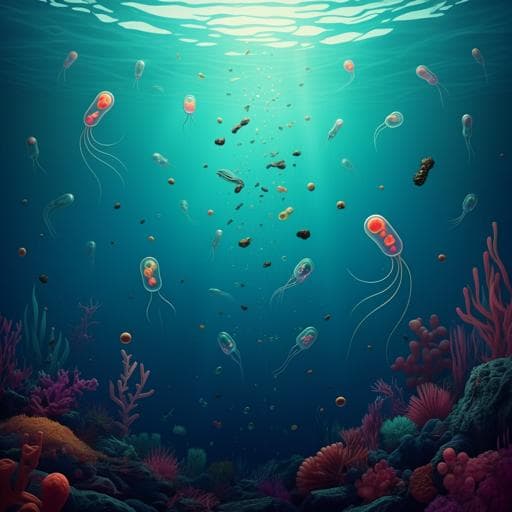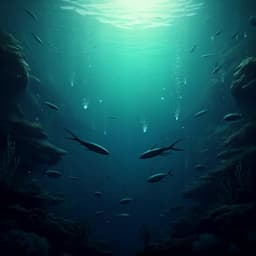
Earth Sciences
What the geological past can tell us about the future of the ocean's twilight zone
K. A. Crichton, J. D. Wilson, et al.
Explore how paleontological reconstructions unveil the intriguing impact of climate on plankton communities in the ocean's twilight zone. Conducted by a team of experts including Katherine A. Crichton, Jamie D. Wilson, and more, this research delves into the consequences of anthropogenic warming and its potential to disrupt marine ecosystems by 2100.
~3 min • Beginner • English
Introduction
The ocean’s mesopelagic or twilight zone (200–1000 m), comprising roughly one quarter of ocean volume, has been considered relatively insulated from anthropogenic impacts due to slow propagation of surface changes to depth. However, changes in surface productivity and export of particulate organic matter (POM) are transmitted to the twilight zone (TZ) within days to weeks via the Biological Carbon Pump (BCP), and subsurface warming is already detectable. The BCP links surface primary production and export of organic matter with remineralization at depth, regulating deep-ocean carbon storage, nutrient recycling, and oxygen distributions. Because metabolic rates approximately double per 10 °C warming, higher temperatures accelerate remineralization, shoal oxygen minima, and reduce food delivery to depth. The research question is whether the geological record of warm climates—when TZ communities were less abundant/diverse and shallower—can inform how ongoing and future anthropogenic warming will alter TZ carbon cycling, oxygenation, and ecology, particularly in low latitudes where temperature effects are most evident.
Literature Review
- Geological and proxy evidence shows early Eocene greenhouse warmth (surface and deep ocean temperatures far above modern), with reduced meridional and surface-to-deep temperature gradients. Prior studies noted a paucity of sedimentary organic carbon in Eocene marine sediments despite indications of high productivity, hypothesized to reflect faster microbial respiration of sinking POC at higher temperatures. Stable carbon isotope (δ13C) depth profiles reconstructed from well-preserved planktonic foraminifera show sharper near-surface gradients and shallower remineralization in the Eocene, supporting enhanced recycling in the upper water column.
- TZ ecology inferred from planktonic foraminifera indicates Eocene pelagic habitats were compressed toward the surface, likely due to reduced food at depth and intensified, shoaled oxygen minimum zones; transient Eocene hyperthermals show signals consistent with food starvation at the seafloor.
- From the mid-Miocene through the Pliocene to Holocene, global cooling coincided with diversification and deepening of subsurface and deep-dwelling planktonic foraminifera, increased occupation of TZ habitats, and a strengthening BCP inferred from increased surface–benthic δ13C gradients and weakened near-surface δ13C-depth gradients. Other plankton groups (e.g., calcareous nannoplankton) also show late Neogene deep-water evolution.
- Modeling frameworks (e.g., cGENIE) have previously been used to link temperature-dependent remineralization to paleo-observations, highlighting the central role of temperature in BCP efficiency and depth structure.
Methodology
- Earth system model: Used the cGENIE Earth system model (muffin v0.9.39). Ocean circulation is a 3D frictional-geostrophic model on a 36×36 equal-area grid (10° longitude by equal sine-latitude spacing) with 16 vertical levels, coupled to a 2D dynamic-thermodynamic sea-ice model and a 2D energy–moisture-balance atmosphere. Biogeochemistry includes ocean carbon, nutrients, oxygen, and air–sea gas exchange.
- Temperature-dependent BCP: Implemented temperature dependence for (i) nutrient uptake/primary production and (ii) remineralization of sinking POC, following prior calibration work. The model configuration without temperature dependence is discussed in supplementary material; main results use the temperature-dependent BCP.
- Paleo configurations and steady-state runs: Applied paleo boundary conditions for the early Eocene and mid-Miocene. Atmospheric CO2 settings used to match proxy-constrained temperatures: Eocene 834 ppm (δ13CO2 −4.5‰), mid-Miocene 1120 ppm (−5.3‰), and preindustrial 280 ppm (−6.5‰). Each simulation was run 10,000 years to equilibrium; outputs from the final year were analyzed. Model–data evaluation includes δ13C-depth profiles and temperature proxies, with best fidelity at low latitudes.
- Future transient experiments: Initialized from preindustrial steady state and forced with historical (1765–2020) CO2 followed by illustrative long-term future scenarios from Winkelmann et al.: F625 (625 PgC), F2500 (2500 PgC), F5000 (5000 PgC) total post-2010 emissions. These scenarios include carbonate compensation and silicate weathering feedbacks and extend for millennia to capture long-term effects. Outputs include global and low-latitude means, and down-column profiles at selected times (2020, 2100, 2300, 3000, 10000 CE).
- Diagnostics and comparisons: Computed surface export flux of POC (at ~80 m), transfer efficiency (fraction of export reaching 1000 m and 600 m), oxygen minimum concentration and depth, δ13C of DIC with depth, and temperature profiles. Emphasis on low latitudes (15°S–15°N), where proxies cluster and model–data agreement is strongest.
- Empirical POC–abundance model: Compiled low-latitude planktonic foraminiferal community abundance data at 600 m from seven time slices spanning mid-Miocene to preindustrial (ref. 8) and paired with site- and time-specific modeled POC flux at 600 m. Constructed a general linear regression across all low-latitude sites: Fraction of community at 600 m = 0.0264 × POC delivery (mg C m−2 d−1) at 600 m; R2 = 0.27, p = 0.002. Applied this transfer function to model-projected POC delivery at 600 m for each future scenario to estimate relative changes in mid-TZ community abundance. Uncertainty shown as ±1 standard deviation from the regression.
Key Findings
- Modeled thermal states (global means): early Eocene SST ~27 °C; mid-Miocene just under 24 °C; preindustrial 19 °C. Benthic (>1000 m) temperatures: Eocene 10 °C; Miocene 4.6 °C; preindustrial 1.5 °C. Low-latitude modeled temperatures align well with proxy constraints.
- Biological Carbon Pump efficiency with warming decreases: Fraction of surface POC export reaching 1000 m is ~2% (Eocene), just over 4% (mid-Miocene), and almost 12% (preindustrial). Warmer climates shoal and intensify the oxygen minimum zone, reduce POC delivery into the TZ, and sharpen near-surface δ13C gradients (stronger recycling). Model δ13C-depth profiles agree with paleo reconstructions where available.
- Paleo synthesis: Geological records indicate compressed pelagic habitats and reduced deep-dweller abundance/diversity during warm intervals (Eocene). Progressive cooling from the mid-Miocene to present coincides with diversification and deepening of TZ-dwelling plankton and a strengthening BCP.
- Future transient response differs from steady-state paleo warmth: In all scenarios (F625, F2500, F5000), transfer efficiency to depth declines early with warming, while surface POC export increases later due to delayed subsurface warming and altered stratification. Consequently, despite potentially exceeding mid-Miocene SSTs in the 22nd century, low-latitude subsurface conditions and POC export remain below mid-Miocene-like values for centuries. Transfer efficiency to 600 m falls below mid-Miocene levels even under mid-range emissions (F2500), making POC delivery to mid-TZ at low latitudes lower-than-mid-Miocene by the mid-23rd century; POC delivery to 200 m becomes lower-than-mid-Miocene before 2100.
- Empirical projection of TZ biotic change: Applying the POC–abundance transfer function suggests mid-TZ community abundance declines already underway by 2020, with peak reductions of about 20% (F625) to ~70% (F5000), followed by very slow recovery over millennia as CO2 declines. These projections reflect food-supply-driven changes and are conservative (no extinctions modeled).
- Overall inference: Temperature-driven acceleration of remineralization and associated oxygen changes are primary controls on food availability and habitat structure in the TZ. Without strong emissions mitigation, widespread TZ ecological disruption is likely by 2100 with long-lived impacts.
Discussion
The study links paleo-observed TZ community structure and carbon cycling to a mechanistic temperature dependence of the BCP. Warmer oceans accelerate microbial remineralization, shoal the remineralization depth and oxygen minima, and diminish POC delivery to TZ depths, reducing food and oxygen availability for mesopelagic biota. Paleo warm states (Eocene, MCO) therefore exhibit shallower, less diverse deep-dwelling communities and weaker BCP transfer to depth, while cooling since the mid-Miocene fostered deeper niches, higher diversity, and stronger deep carbon sequestration.
When transposed to the anthropogenic context, transient surface-intensified warming and increased stratification cause a rapid decline in transfer efficiency before a delayed rise in surface export, producing a mismatch with steady-state paleo analogs. Thus, even if surface temperatures approach or exceed mid-Miocene levels, subsurface conditions and POC delivery can remain more limiting than in the Miocene for centuries, especially at mid-TZ depths. Empirical projections from the foraminifera-based transfer function suggest substantial reductions in mid-TZ community abundance driven by decreased POC flux, with potential compounding stresses from increased metabolic demand, reduced oxygen solubility, OMZ shoaling, and acidification. The rapid, transient nature of future change may outpace ecological and evolutionary adaptation, creating novel environmental combinations (warmer, less oxygenated, less food) and implying greater ecological risk than steady-state paleo analogs would suggest.
Conclusion
By integrating paleo reconstructions with a temperature-dependent Earth system model, the study demonstrates that ocean warming weakens the BCP’s transfer of organic matter to depth, shoals and intensifies OMZs, and compresses/depletes twilight zone communities. Paleo warm intervals show diminished deep POC fluxes and reduced deep-dweller abundance/diversity; cooling since the mid-Miocene strengthened the BCP and expanded TZ habitats. Future projections indicate early declines in transfer efficiency and food supply to mid-TZ depths, with potential reductions in mesopelagic community abundance of ~20–70% depending on emissions, and millennial-scale recovery times. The work underscores that steady-state geological analogs are informative mechanistically but differ from transient anthropogenic forcing, emphasizing the need for strong emissions mitigation to avoid widespread TZ disruption.
Future research should improve observational coverage of the TZ, develop higher-resolution coupled models including DOM temperature dependence and ecosystem dynamics, expand multi-taxon paleo-ecological datasets, and better constrain regional variability and thresholds for habitat compression and deoxygenation.
Limitations
- Model resolution and physics: The ocean model is low resolution (10°) with a simplified atmospheric component and lacks interannual variability, limiting geographic detail and robustness relative to fully coupled CMIP-class models. The model underestimates reduced meridional temperature gradients in past warm climates (polar surface bias).
- Paleo data sparsity: Eocene δ13C-depth profiles are available from only a single location, increasing uncertainty relative to Miocene and modern comparisons.
- Process representation: Main-text simulations omit temperature dependence in dissolved organic matter cycling (discussed in supplements). Ecosystem structure and adaptive behaviors are simplified and not explicitly modeled.
- Empirical transfer function: The foraminifera-based POC–abundance relationship has modest explanatory power (R2 = 0.27) and assumes foraminifera represent the broader TZ ecosystem; it is linear, reversible, and does not allow for extinction or nonlinear thresholds. It implicitly conflates co-varying factors (oxygen, acidification, metabolic demand) with food supply.
- Transient vs. steady-state analogs: Paleo analogs represent near steady-state oceans, whereas anthropogenic warming is transient and top-down, limiting direct quantitative analogies.
Related Publications
Explore these studies to deepen your understanding of the subject.







